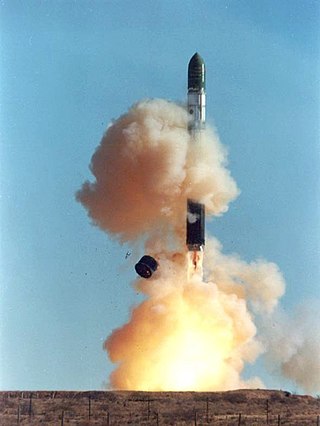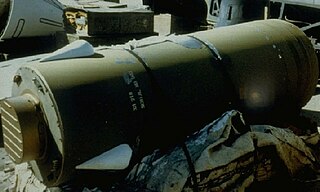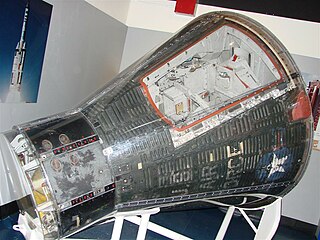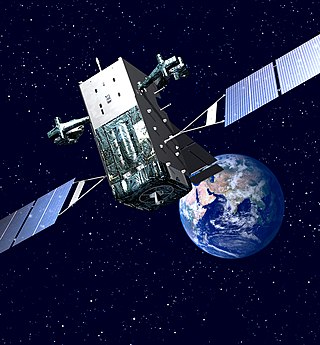Related Research Articles

The Trident missile is a submarine-launched ballistic missile (SLBM) equipped with multiple independently targetable reentry vehicles (MIRV). Originally developed by Lockheed Missiles and Space Corporation, the missile is armed with thermonuclear warheads and is launched from nuclear-powered ballistic missile submarines (SSBNs). Trident missiles are carried by twelve United States Navy Ohio-class submarines, with American warheads, as well as four Royal Navy Vanguard-class submarines, with British warheads. The missile is named after the mythological trident of Neptune.

Energia was a 1980s super-heavy lift launch vehicle. It was designed by NPO Energia of the Soviet Union as part of the Buran program for a variety of payloads including the Buran spacecraft. Control system main developer enterprise was the Khartron NPO "Electropribor". The Energia used four strap-on boosters each powered by a four-chamber RD-170 engine burning kerosene/LOX, and a central core stage with four single-chamber RD-0120 (11D122) engines fueled by liquid hydrogen/LOX.

Atmospheric entry is the movement of an object from outer space into and through the gases of an atmosphere of a planet, dwarf planet, or natural satellite. There are two main types of atmospheric entry: uncontrolled entry, such as the entry of astronomical objects, space debris, or bolides; and controlled entry of a spacecraft capable of being navigated or following a predetermined course. Technologies and procedures allowing the controlled atmospheric entry, descent, and landing of spacecraft are collectively termed as EDL.

Convair, previously Consolidated Vultee, was an American aircraft-manufacturing company that later expanded into rockets and spacecraft. The company was formed in 1943 by the merger of Consolidated Aircraft and Vultee Aircraft. In 1953, it was purchased by General Dynamics, and operated as their Convair Division for most of its corporate history.

The PGM-17A Thor was the first operative ballistic missile of the United States Air Force (USAF). It was named after the Norse god of thunder. It was deployed in the United Kingdom between 1959 and September 1963 as an intermediate-range ballistic missile (IRBM) with thermonuclear warheads. Thor was 65 feet (20 m) in height and 8 feet (2.4 m) in diameter.

The Boeing X-20 Dyna-Soar was a United States Air Force (USAF) program to develop a spaceplane that could be used for a variety of military missions, including aerial reconnaissance, bombing, space rescue, satellite maintenance, and as a space interceptor to sabotage enemy satellites. The program ran from October 24, 1957, to December 10, 1963, cost US$660 million, and was cancelled just after spacecraft construction had begun.
A circular wing is a disc-shaped wing having the outer planform of a circle.

The R-36 is a family of intercontinental ballistic missiles (ICBMs) and space launch vehicles (Tsyklon) designed by the Soviet Union during the Cold War. The original R-36 was deployed under the GRAU index 8K67 and was given the NATO reporting name SS-9 Scarp. It was able to carry three warheads and was the first Soviet MRV missile. The later version, the R-36M, also known as RS20, was produced under the GRAU designations 15A14 and 15A18 and was given the NATO reporting name SS-18 Satan. This missile was viewed by certain United States analysts as giving the Soviet Union first strike advantage over the U.S., particularly because of its rapid silo-reload ability, very heavy throw weight and extremely large number of re-entry vehicles. Some versions of the R-36M were deployed with 10 warheads and up to 40 penetration aids and the missile's high throw-weight made it theoretically capable of carrying more warheads or penetration aids. Contemporary U.S. missiles, such as the Minuteman III, carried up to three warheads at most.
This is an alphabetical list of articles pertaining specifically to aerospace engineering. For a broad overview of engineering, see List of engineering topics. For biographies, see List of engineers.

The W71 nuclear warhead was a US thermonuclear warhead developed at Lawrence Livermore National Laboratory in California and deployed on the LIM-49A Spartan missile, a component of the Safeguard Program, an anti-ballistic missile (ABM) defense system briefly deployed by the US in the 1970s.

The W62 was an American thermonuclear warhead designed in the 1960s and manufactured from March 1970 to June 1976. Used on some Minuteman III ICBMs, it was partially replaced by the W78 starting in December 1979, and fully replaced by W87 warheads removed from MX Peacekeeper missiles and retired in 2010.

An aeroshell is a rigid heat-shielded shell that helps decelerate and protects a spacecraft vehicle from pressure, heat, and possible debris created by drag during atmospheric entry. Its main components consist of a heat shield and a back shell. The heat shield absorbs heat caused by air compression in front of the spacecraft during its atmospheric entry. The back shell carries the load being delivered, along with important components such as a parachute, rocket engines, and monitoring electronics like an inertial measurement unit that monitors the orientation of the shell during parachute-slowed descent.

USA-193, also known as NRO Launch 21, was a United States military reconnaissance satellite launched on 14 December 2006. It was the first launch conducted by the United Launch Alliance (ULA). Owned by the National Reconnaissance Office (NRO), the craft's precise function and purpose were classified. On 21 February 2008, it was destroyed as a result of Operation Burnt Frost.

Pye Wacket was the codename for an experimental lenticular-form air-to-air missile developed by the Convair Division of the General Dynamics Corporation in 1957. Intended as a defensive missile for the B-70 Valkyrie Mach 3 bomber, the program saw extensive wind-tunnel testing and seemed promising; however, the cancellation of the B-70 removed the requirement for the missile, and the project was cancelled.
The Wagtail missile, also known as "Wag Tail", was a short-range nuclear missile developed in the late 1950s by Minneapolis-Honeywell under a contract awarded by the United States Air Force. Intended for use as an auxiliary weapon by bomber aircraft, the missile was successfully test fired in 1958, but the program was cancelled in the early 1960s.

The Low-Density Supersonic Decelerator or LDSD is a reentry vehicle designed to test techniques for atmospheric entry on Mars. The disc-shaped LDSD uses an inflatable structure called the Supersonic Inflatable Aerodynamic Decelerator (SIAD), which is essentially a donut-shaped balloon, to create atmospheric drag in order to decelerate the vehicle before deploying a large supersonic parachute. The goal of the $230 m project is to develop a reentry system capable of landing 2- to 3-ton payloads on Mars, as opposed to the 1-ton limit of the currently used systems.

Gemini SC-2 was the second NASA Project Gemini full-up reentry capsule built. This McDonnell Gemini capsule was the first space capsule to be reused, flying twice in suborbital flights. SC-2 flew on Gemini 2 and OPS 0855 flights. The capsule is currently on display at the Air Force Space and Missile Museum at Cape Canaveral Air Force Station.

USA-282, also known as SBIRS GEO-4, is a United States military satellite and part of the Space-Based Infrared System.

Orbiting Vehicle 1-8, launched 14 July 1966, was the seventh satellite launched in the OV1 series of the United States Air Force's Orbiting Vehicle program. OV1-8 was designed to test the passive communications utility of an aluminum grid sphere versus a balloon satellite.
References
- ↑ Popular Mechanics, November 2000 "America's Nuclear Flying Saucer" Retrieved June 23, 2010
- 1 2 Oberto, R. J. (1962, October). Environmental control systems selection for manned space vehicles. Volume II, Appendix I, missions, vehicles, equipment. (AD333266).
- ↑ Parsch, A. (2003-2005). Pye Wacket Archived May 11, 2016, at the Wayback Machine
- ↑ Hilton, W. F. (1958, April). Flying saucers: Are they best for space flight? Aircraft and Missiles Manufacturing, pp. 50, 51, 82.
- ↑ Anderson, A. (1960, March). Force tests of lenticular configurations at supersonic speeds. (AD0315671).
- ↑ Blanchard, U. J. (1961, September). Landing characteristics of a lenticular-shaped re-entry vehicle. (AD263072)
- ↑ Maccabee, B. (1997). Acceleration. Archived December 11, 2006, at the Wayback Machine
- ↑ Industry Observer. // Aviation Week & Space Technology, June 3, 1963, v. 78, no. 22, p. 19.